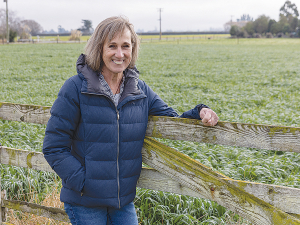2024/25 Dairy Statistics: NZ dairy farmers boost production with fewer cows
According to the New Zealand Dairy Statistics 2024/25 report, New Zealand dairy farmers are achieving more with fewer cows.
 Fernside farmer Julie Bradshaw has refined her dairy herd size by genomics while maintaining the same level of milk production.
Fernside farmer Julie Bradshaw has refined her dairy herd size by genomics while maintaining the same level of milk production.
Over the past two years, Fernside farmer Julie Bradshaw has refined her dairy herd size using genomics while maintaining the same level of milk production.
Julie has been participating in a Next Generation Farming project designed to help farmers meet tough nitrate caps while maintaining their viability. As part of this project, farmers like Julie are using innovation to demonstrate productivity and environmental benefits to their neighbours in the region and beyond.
Waimakariri Landcare Trust (WLT) and Waimakariri Irrigation Limited (WIL) have partnered with the Ministry for Primary Industries (MPI) for the project, with support from MPI’s Sustainable Food and Fibre Futures fund along with Environment Canterbury, Ballance, and DairyNZ.
The biggest change Julie has made on her farm over the last two years is closely examining her herd selection process using genomic data.
Julie has already reduced her herd size by 15 cows and is planning to remove 10 of last year’s calves based on genomic data she has received from LIC. She credits the reliability of the information with helping her to make these science-based decisions.
“The advances in the data we are getting now, and the reliability of that data means that we can be certain about which animals to keep.
“There is no point paying for grazing for animals for three or four years that that don’t end up being productive dairy cows.
“With the reductions I have made I have still retained the same level of milk production, so I know I have made the right decision.”
In the past, Julie would have retained cows with low BW (Breeding Worth) but with the possibility of reductions in the numbers of cows on farms in the future, she wants to ensure that her herd is performing at its best.
“When you look at what is happening overseas you can see that farmers have already reduced their herd numbers and it is only a matter of time before it happens here.
“It is challenging but you need to look at your entire farming operation and see what you can do to farm more efficiently. With all the science and data that we can access now it makes sense to use all the tools you have in your toolbox.”
Julie says she believes genomics and scientific innovation will play an increasingly significant role in New Zealand farming in the future.
“When I look at the data, I am getting now compared to a few years ago it is amazing. I think the data will continue to improve as more herds get involved and this will be a huge benefit to everyone involved in the farming industry.”
Julie has shared what she learned from the innovation project with local farmers and she says most of them are keen to know more about her journey and can see the benefits of using science to improve their farms.
“Farmers are supportive and willing to share what they have learned. If you are a farmer who is open to innovation and new ideas, I believe you will be able to continue to farm into the future and have a successful farming business.”
At Pāmu’s Kepler Farm in Manapouri, mating has wrapped up at the across-breed Beef Progeny Test.
More than 150 people turned up at Parliament recently to celebrate the 20th anniversary of Horticulture New Zealand (HortNZ).
Biosecurity New Zealand says Kiwis should continue to keep an eye out for yellow-legged hornets (Vespa velutina) over the holiday season.
The Push-Up Challenge, an event which combines mental health and fitness, is set to launch in New Zealand in 2026.
Last month's Agritechnica event led to a wide group of manufacturers celebrating successes when the 2026 Tractor of the Year Competition winners, selected by a panel of European journalists, were announced in Hanover Germany.
According to the latest Federated Farmers banking survey, farmers are more satisfied with their bank and less under pressure, however, the sector is well short of confidence levels seen last decade.
President Donald Trump’s decision to impose tariffs on imports into the US is doing good things for global trade, according…
Seen a giant cheese roll rolling along Southland’s roads?